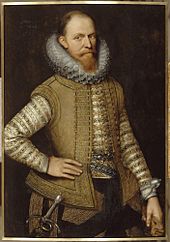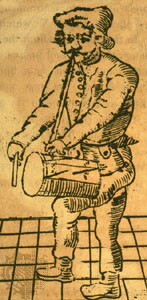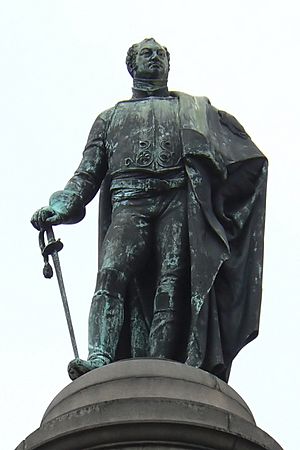The Grand Old Duke of York facts for kids
Quick facts for kids "The Grand Old Duke of York" |
|
|---|---|
| Nursery rhyme | |
| Published | 1642 |
| Songwriter(s) | unknown |
"The Grand Old Duke of York" (sometimes called The Noble Duke of York) is a famous English children's nursery rhyme. People often sing it as an action song, where you do movements while singing. The song talks about a duke, and many people have wondered which real duke it's about. The words of the song have become a common saying for doing something that doesn't really achieve anything.
Contents
Lyrics
Here are the words to the most common version of the song today:
Oh, the grand old Duke of York,
He had ten thousand men;
He marched them up to the top of the hill,
And he marched them down again.
When they were up, they were up,
And when they were down, they were down,
And when they were only halfway up,
They were neither up nor down.
Actions
People often do actions when they sing "The Grand Old Duke of York." The main idea is to stand up when the song says "up" and sit down when it says "down." When the song says "only halfway up," you might crouch or stand halfway.
If you start sitting, like in a school assembly, you should end the song back in your seat. For the first part of the song, the actions are slow and easy. You might even add more actions, like saluting for the "Duke of York." You could also show ten fingers for "ten thousand men" or make your hands look like a hill.
The second part of the song is much faster! You have to change positions quickly. This song is a fun game that helps young children move and work together. It's often used as an easy way to get kids active.
Origins
Like many old nursery rhymes, the exact start of "The Grand Old Duke of York" is a bit of a mystery. People have discussed it a lot, but no one knows for sure. The song clearly talks about a real person, a "Duke of York." So, many debates have tried to figure out which duke it was.
The words we sing today weren't printed until 1913 in a book called Mother Goose by Arthur Rackham. Before that, different versions existed. For example, in 1892, people in Warwickshire sang it about both the Duke of York and the King of France. By 1894, some sang it about Napoleon.
The oldest known version of the song is from 1642. It was called 'Old Tarlton's song' and was linked to a famous clown named Richard Tarlton. His version had these words:
The King of France with forty thousand men,
Came up a hill and so came downe againe.
Because of this, some people think the song was a common funny verse that changed over time. It might have been adapted to fit different people or events. Since it was written down with the Duke of York, that version became the most popular.
Here are some of the dukes people think the song might be about:
- Richard, Duke of York (1411–1460): He was a leader during the Wars of the Roses. In 1460, his army, about 8,000 men, was waiting at Sandal Castle. He decided to attack a much larger enemy army. Richard and many of his soldiers died in the battle.
- James II (1633–1701): He was once the Duke of York. In 1688, he marched his troops to Salisbury Plain to stop an invasion. But his supporters left him, so he had to retreat and send his soldiers home.
- Prince Frederick, Duke of York and Albany (1763–1827): This is the most common guess. He was the second son of King George III. He was a top commander in the British Army during wars against France. In 1793–94, he led troops in a campaign in Flanders. Even though his troops had some success, he had to retreat. Flanders is mostly flat, but there is a town called Cassel on a hill. This hill rises about 176 meters (570 feet) above the flat land. Some people think this might be the "hill" in the song.
Even with these ideas, there's no clear proof that the song is about any of these specific dukes.
Song
"The Grand Old Duke of York" is also sung to the tune of another well-known song, "A-Hunting We Will Go".
Dutch version

There is a version of this song in the Dutch language. Instead of the Duke of York, it talks about Maurice, Prince of Orange (1567–1625). Prince Maurice was famous for training his soldiers in new ways. At first, people made fun of his methods, but they became very successful in war. We don't know when the British song traveled to the Netherlands. But today, it's a very popular song in the Dutch scouting movement.
|
De held prins Maurits kwam |
The hero Prince Maurice came |



